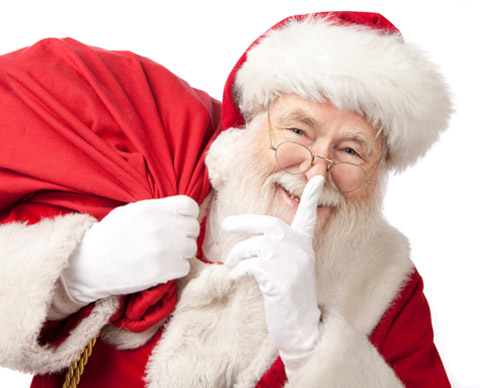当前位置: Language Tips> 合作专区> 英语学习专栏
圣诞老人源于欧洲的民间传说,一般认为圣诞老人来自北极,如芬兰的拉普兰地区有一个圣诞老人村。每年圣诞节,总会有小孩儿寄信给圣诞老人,告知其希望收到的圣诞礼物,而邮局更会有专人回复这些信件。睡梦中圣诞老人送惊喜是孩子们一年一度的殷切期盼,而父母们则借机鼓励他们听话、好好表现。但随着年龄的增长,孩子的心里逐渐有了疑问:真的有圣诞老人吗?请看作者如何解开孩子们这一心中疑团。

By Betty Liu
郭小华 注
Christmas is perhaps the most important holiday in American culture. It is certainty a favorite, especially among children everywhere. On Christmas Eve, children sit out with parents in the living room hanging stockings, setting up a Christmas tree, eating candy canes, and setting up milk and cookies for Santa Claus. Perhaps the most beloved figure in American history, Santa Claus has become an important icon for Christmas.
They say that Santa Claus usually lives in the North Pole in his workshop with his wife, Mrs. Claus and his worker elves (who make the toys). Children from all over the world write to him to tell him what they want for Christmas. On Christmas Eve, he travels the world on his sleigh, which is pulled by his magic reindeer, and visits all the good little boys and girls of the world. He comes down the chimney and fills their stockings with treats and leaves them presents under the tree. However, naughty boys and girls don’t receive gifts and they will get lumps of coal in their stockings.
I remember believing in Santa when I was a very young girl. However, as I grew older, I learned many facts that “proved” his existence as false. Always inquisitive by nature and very keen on the scientific method of experimentation, I was determined to use tests and observations to determine whether Santa Claus was real.
The first year of tests happened when I was 5. I decided that if I stayed up all night on Christmas Eve, I could see if Santa really did come down the chimney. However, that was a futile attempt. I fell asleep that year, and when I woke up I saw that the milk and cookies I left for Santa were all gone and I had a beautifully wrapped present under the tree.
The next year, I was able to test if location was an issue with Santa’s deliveries. That year, my family spent Christmas with the family of one of my mother’s friends. At the time, I decided that if Santa was all-knowing (as the song says “He knows where you are sleeping, he knows when you’re awake. He knows if you’ve been bad or good, so be good for goodness’ sake!) he would know I wasn’t home. Sure enough, there was a pretty pink package waiting for me the next morning, and inside was a pretty pink bathrobe.
At age 7, I came up with my ultimate test to see if Santa was real. That year, I didn’t send out my Christmas letter to Santa. At first it was because I didn’t want anything for Christmas, but this turned into a plot. By this point, I already decided that Santa wasn’t real, but I wanted empirical evidence to support this (it’s much harder to try to prove something doesn’t exist, rather than trying to prove that it does). That year was interesting, because on Christmas Eve, my mother dragged me to our local Wal-Mart and led me around the toy section. I refused to say a word, but did let my eye linger on a ballet set. I figured that “Santa” wouldn’t know what to get me because he shouldn’t be able to read my mind. However, mother would know everything that caught my eye in the store. If I got the ballet set the next morning, I would have my evidence. Christmas morning, there was the ballet set, sitting under the tree. As I didn’t use it much, mother ended up returning it a few days later. She claimed Santa was generous enough to leave a receipt. That was the end to my mission to discover the existence of Santa.
Now, I can look back on all of these antics with fond nostalgia. The magic and mystery of it all made Christmas a fun time. Santa was a big part of my childhood, and in the future, I want it to be a part of my child’s as well.
Vocabulary
1. Santa Claus: 圣诞老人,源于欧洲的民间传说,最经典的形象是头戴红色圣诞帽子,留着白色大胡子,身穿红色棉衣,脚登红色靴子。传说每到12月24日晚上,他都会驾乘12头驯鹿拉着的雪橇,从烟囱进入屋里,偷偷地把礼物放在好孩子床头的袜子里,或者堆在壁炉旁的圣诞树下。
2. Christmas: 圣诞节,基督教节日,定在12月25日,纪念耶稣的诞生。
3. 圣诞前夜,孩子们与父母一起坐到深夜,在客厅悬挂长筒袜,摆放圣诞树,吃棒棒糖,并为圣诞老人准备牛奶和饼干。Christmas Eve: 圣诞前夜,平安夜;sit out: 坐到结束;stocking: 长筒袜;candy cane: 一种红白相间、一端弯曲的棒棒糖,也叫拐杖糖,形状像英文字母J,代表耶稣基督的圣名,常在圣诞节吃。
4. beloved: 钟爱的,受爱戴的;icon: 圣像,图标。
5. North Pole: 北极;elf: 小精灵。
6. sleigh: 雪橇;reindeer: 驯鹿(体型较大,生有枝状角,生活在北极地区)。
7. chimney: 烟囱;treats: 好吃的,好玩的。
8. naughty: 淘气的;lump: 块,团。
9. prove: 证明某事属实,原来是;false: 虚假的。
10. 由于我天生好打听,且非常热衷于科学实验方法,因此我下决心要通过试验和观察来确定圣诞老人是否确有其人。inquisitive: 好奇的,好打听别人的事情的;by nature: 生性,天生地;keen on: 热衷于。
11. stay up: 熬夜,不睡觉;all night: 整夜,通宵。
12. futile: 无效的,无用的;attempt: 尝试。
13. leave…for: 留下,留给某人;wrap: 包,裹。
14. location: 地点,位置;delivery: 投递,交付。
15. all-knowing: 无所不知;for goodness’ sake: 看在上帝(老天爷)份上,务请。
16. sure enough: 果然,确实;bathrobe: 浴袍。
17. come up with: 提出,想出; ultimate: 最后的,终极的。
18. 此时,我已经确信圣诞老人不是确有其人,但我想通过经验证据来证明这一点(要证明某物并不存在比证明它确实存在可难多了)。empirical evidence: 经验证据;support: 支持,证明。
19. drag: 拉,扯;Wal-Mart: 沃尔玛百货有限公司,美国跨国零售企业,总部设在阿肯色州本顿维尔,是世界上最大的连锁零售商;section: 区,部分。
20. linger on: 流连,继续逗留;ballet: 芭蕾舞。
21. figure: 想,估计;read one’s mind: 看出某人的心思。
22. catch one’s eye: 吸引某人注意。
23. claim: 声称;generous: 慷慨;receipt: 收据。
24. look back on: 回顾,回想;antics: 滑稽动作,古怪姿态;nostalgia: 怀旧,对往事的怀恋。
25. magic: 魔法;mystery: 神秘;fun time: 快乐时光。
(来源:英语学习杂志 编辑:丹妮)
上一篇 : 瓦格纳的圣诞诺言
下一篇 : 美国传统节日——校友返校周
关注和订阅


电话:8610-84883645
传真:8610-84883500
Email: languagetips@chinadaily.com.cn